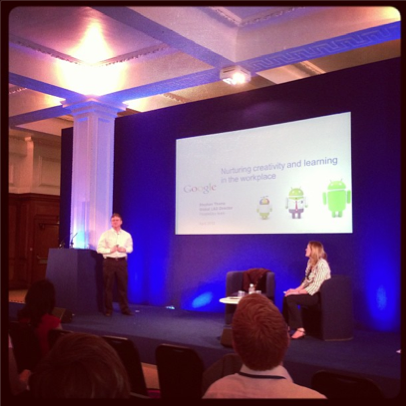This is a live blog from the CIPD HRD session Nurturing creativity and learning in the workplace given by Stephan Thoma, director of L&D in Google’s PeopleDev team.
We are not a hierarchical org. What we do suits us – no best practices, it is all situational.
Google Plus, Chrome, Youtube and Android are our biggest brands. We are big and touch a lot of people everyday. We are also very young – only 14 years old. Now have 37,000 people in 70 offices in more than 40 countries.
Our product pipeline is being kept alive by our creativity. Behind the big products are many more products – we are an innovation engine. If we cannot keep product innovation alive we will die. We are not a marketing led organisation, the ideas come from our engineers. We focus on product innovation.
Gmail cam from two engineers who wanted to apply search algorithm to email. That was the genesis of en.
The challenge is to keep things creative and challenging and remain unconventional. These three elements are really important: creativity, challenge, being unconventional.
The culture and climate are based on a small company feel, cognitive ability, analytical rigour. People need to be very sharp and very good at thinking. In all functions. Conceptual flexibility also really important – the ability to step back and find another way. Emphasis on innovation and transparency. Every Friday execs are available for questions.
The fast beat the slow – want to get products out fast, test and iterate. We eat our own dogwood, we test our own things before they go to market. This is the same across all functions. And we have 20% time for colleagues in which they pursue their own projects.
Innovation at scale
Innovation can come from anywhere in the company. Individuals need autonomy to do this but there needs to be top down guidance otherwise there would be chaos. Learning is a key part of this process.
Google has lots of Gen Y people who are good at collaborating but hard to manage. They have high expectations and are learning anyway. Find and create and resource they need. What do you do to help about these people?
We are known for our food. It is not done as a benefit. In the early days a lot of the work was done over a pizza. This is where the serendipitous interactions take place.
Our talent philosophy is: if you give people freedom, they will amaze you. Find them, grow them, keep them.
We try and hire the best we can and learning and growth is a part of the deal. We have high standards. We hire for leadership, general cognitive ability and Googliness (being able to operate with fun and deep analytics and insight.
We look after new hires very well for the first six months.
L&D supports learners with what they are doing and adding what they need. But there is a lot of natural learning and Googlers using our tools to find things. We are a rich environment for tacit knowledge and we need to ensure we do not snuff that out.
We have built an ecosystem of learners and learn-ed. We support G2G – our peer learning community. This is top down and bottom up – a large community now. And g2gTV shares peer content.
A lot of what we do is face to face – bringing people together is really important. We also bring in external suppliers too.
The g2g community content is peer rated. Best stuff rises to the top.
We have learning paths to link up content and classes that are available. People can publish their own learning pathways.
Now toying with a recommendation engine to recommend learning. Also trying out skills tagging – people tag their skills and peers do that too. These people can then be used for mentoring, coaching etc.
We are currently ‘dogfooding’ Goggle hangouts for learning. Redesigning our content to be hangout friendly. Found that Googlers are more interactive than in face to face sessions.
Also experiencing flipped classrooms. Interaction via hangouts.
In leadership and teamwork development programme we fed content to people, delivered community based assignments, managed flow through reminders, debriefs in Hangouts. Result was that it was more effective and cheaper.
Conclusion
- Culture and climate is vital
- Innovate in learning
- Follow 70:20:10 loosely
- Community is key
- Top down and bottom up approach




